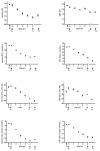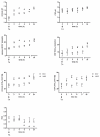Infusion of sodium bicarbonate in experimentally induced metabolic acidosis does not provoke cerebrospinal fluid (CSF) acidosis in calves
- PMID: 22754090
- PMCID: PMC3244283
Infusion of sodium bicarbonate in experimentally induced metabolic acidosis does not provoke cerebrospinal fluid (CSF) acidosis in calves
Abstract
In a crossover study, 5 calves were made acidotic by intermittent intravenous infusion of isotonic hydrochloric acid (HCl) over approximately 24 h. This was followed by rapid (4 h) or slow (24 h) correction of blood pH with isotonic sodium bicarbonate (NaHCO(3)) to determine if rapid correction of acidemia produced paradoxical cerebrospinal fluid (CSF) acidosis. Infusion of HCl produced a marked metabolic acidosis with respiratory compensation. Venous blood pH (mean ± S(x)) was 7.362 ± 0.021 and 7.116 ± 0.032, partial pressure of carbon dioxide (Pco(2), torr) 48.8 ± 1.3 and 34.8 ± 1.4, and bicarbonate (mmol/L), 27.2 ± 1.27 and 11 ± 0.96; CSF pH was 7.344 ± 0.031 and 7.240 ± 0.039, Pco(2) 42.8 ± 2.9 and 34.5 ± 1.4, and bicarbonate 23.5 ± 0.91 and 14.2 ± 1.09 for the period before the infusion of hydrochloric acid and immediately before the start of sodium bicarbonate correction, respectively. In calves treated with rapid infusion of sodium bicarbonate, correction of venous acidemia was significantly more rapid and increases in Pco(2) and bicarbonate in CSF were also more rapid. However, there was no significant difference in CSF pH. After 4 h of correction, CSF pH was 7.238 ± 0.040 and 7.256 ± 0.050, Pco(2) 44.4 ± 2.2 and 34.2 ± 2.1, and bicarbonate 17.8 ± 1.02 and 14.6 ± 1.4 for rapid and slow correction, respectively. Under the conditions of this experiment, rapid correction of acidemia did not provoke paradoxical CSF acidosis.
Dans une étude croisée, une acidose a été induite chez 5 veaux par infusion intraveineuse intermittente d’acide hydrochlorique (HCl) isotonique sur une période d’environ 24 h. Ceci était suivi par une correction rapide (4 h) ou lente (24 h) du pH sanguin à l’aide de bicarbonate de soude (NaHCO3) isotonique afin de déterminer si une correction rapide de l’acidémie induisait une acidose paradoxale du liquide céphalo-rachidien (LCR). L’infusion d’HCl a induit une acidose métabolique marquée avec compensation respiratoire. Pour la période, respectivement, avant le début de l’infusion de HCl et celle immédiatement avant le début de la correction avec le bicarbonate de sodium, le pH sanguin veineux (moyenne ± Sx) était de 7,362 ± 0,021 et 7,116 ± 0,032, la pression partielle de dioxyde de carbone (Pco2, torr) 48,8 ± 1,3 et 34,8 ± 1,4, et le bicarbonate (mmol/L), 27,2 ±1,27 et 11 ± 0,96; pour le LCR le pH était de 7,344 ± 0,031 et 7,240 ± 0,039, la Pco2 de 42,8 ± 2,9 et 34,5 ± 1,4, et le bicarbonate 23,5 ± 0,91 et 14,2 ± 1,09. Chez les veaux traités par une infusion rapide de bicarbonate de sodium, la correction de l’acidémie était significativement plus rapide et des augmentations de la Pco2 et du bicarbonate dans le LCR étaient également plus rapides. Toutefois, il n’y avait pas de différence significative dans le pH du LCR entre une infusion rapide et lente. Après 4 h de correction, le pH du LCR était de 7,238 ± 0,040 et 7,256 ± 0,050, la Pco2 de 44,4 ± 2,2 et 34,2 ± 2,1, et le bicarbonate 17,8 ± 1,02 et 14,6 ± 1,4 pour une correction rapide et lente, respectivement. Dans les conditions expérimentales de la présente étude, une correction rapide de l’acidémie n’a pas provoqué d’acidose paradoxale du LCR.
(Traduit par Docteur Serge Messier)
Figures



Similar articles
-
Effects of intravenous hyperosmotic sodium bicarbonate on arterial and cerebrospinal fluid acid-base status and cardiovascular function in calves with experimentally induced respiratory and strong ion acidosis.J Vet Intern Med. 2005 Mar-Apr;19(2):240-51. doi: 10.1892/0891-6640(2005)19<240:eoihsb>2.0.co;2. J Vet Intern Med. 2005. PMID: 15822570 Clinical Trial.
-
Importance of the effective strong ion difference of an intravenous solution in the treatment of diarrheic calves with naturally acquired acidemia and strong ion (metabolic) acidosis.J Vet Intern Med. 2012 May-Jun;26(3):674-83. doi: 10.1111/j.1939-1676.2012.00917.x. Epub 2012 Apr 4. J Vet Intern Med. 2012. PMID: 22486951 Clinical Trial.
-
Construction and validation of a decision tree for treating metabolic acidosis in calves with neonatal diarrhea.BMC Vet Res. 2012 Dec 6;8:238. doi: 10.1186/1746-6148-8-238. BMC Vet Res. 2012. PMID: 23216654 Free PMC article.
-
Sodium bicarbonate for the treatment of lactic acidosis.Chest. 2000 Jan;117(1):260-7. doi: 10.1378/chest.117.1.260. Chest. 2000. PMID: 10631227 Review.
-
Apparent bicarbonate space in children.ScientificWorldJournal. 2006 Jan 26;6:148-53. doi: 10.1100/tsw.2006.32. ScientificWorldJournal. 2006. PMID: 16493519 Free PMC article. Review.
Cited by
-
Dialysis disequilibrium syndrome (DDS) in pediatric patients on dialysis: systematic review and clinical practice recommendations.Pediatr Nephrol. 2022 Feb;37(2):263-274. doi: 10.1007/s00467-021-05242-1. Epub 2021 Oct 5. Pediatr Nephrol. 2022. PMID: 34609583
-
The effects of sodium bicarbonate infusion on cerebrovascular function in newborn pigs.Pediatr Res. 2022 Sep;92(3):729-736. doi: 10.1038/s41390-021-01876-x. Epub 2021 Dec 3. Pediatr Res. 2022. PMID: 34862458 Free PMC article.
-
Dialysis disequilibrium syndrome prevention and management.Int J Nephrol Renovasc Dis. 2019 Apr 30;12:69-77. doi: 10.2147/IJNRD.S165925. eCollection 2019. Int J Nephrol Renovasc Dis. 2019. PMID: 31118737 Free PMC article. Review.
-
Comparison of the alkalizing abilities between 1.35% sodium bicarbonate solutions with and without dextrose in healthy calves.J Vet Med Sci. 2022 Sep 21;84(10):1335-1339. doi: 10.1292/jvms.22-0289. Epub 2022 Aug 17. J Vet Med Sci. 2022. PMID: 35979555 Free PMC article.
-
Intravenous and Oral Fluid Therapy in Neonatal Calves With Diarrhea or Sepsis and in Adult Cattle.Front Vet Sci. 2021 Jan 27;7:603358. doi: 10.3389/fvets.2020.603358. eCollection 2020. Front Vet Sci. 2021. PMID: 33585594 Free PMC article. Review.
References
-
- Charles JC, Heilman RL. Metabolic acidosis. Hosp Physician. 2005;41:37–42.
-
- Kasari TR, Naylor JM. Clinical evaluation of sodium bicarbonate, sodium L-lactate and sodium acetate for the treatment of acidosis in diarrheic calves. J Am Vet Med Assoc. 1985;187:392–397. - PubMed
-
- Naylor JM, Zello GA, Abeysekara S. Advances in oral and intravenous fluid therapy of calves with gastrointestinal disease. Proc World Buiatrics Congress. 2006;24:139–150.
-
- Sen I, Altunok V, Ok M, Coskun A, Constable PD. Efficacy of oral rehydration therapy solutions containing sodium bicarbonate or sodium acetate for treatment of calves with naturally acquired diarrhea, moderate dehydration, and strong ion acidosis. J Am Vet Med Assoc. 2009;234:926–934. - PubMed
MeSH terms
Substances
LinkOut - more resources
Full Text Sources
